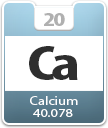Atomic Number of Calcium

Atomic Number of Calcium is 20.
Chemical symbol for Calcium is Ca. Number of protons in Calcium is 20. Atomic weight of Calcium is 40.078 u or g/mol. Melting point of Calcium is 839 °C and its the boiling point is 1487 °C.
» Boiling Point » Melting Point » Abundant » State at STP » Discovery YearAbout Calcium
One of the most important elements for humans and animals, calcium is a light and soft metal of light grey color. It is very reactive, especially with water and air. It has got its name from a Latin word meaning lime. It is impossible to find pure calcium in nature, but it can be found in abundance in various chemical compounds, thus it is considered to be the fifth most abundant element on the surface of earth. We receive calcium with foods and when brushing our teeth. In a human body, we have about 1 kilogram of calcium which is mainly in our bones and teeth. Calcium is used in metallurgy to produce alloys with other metals, as well as in chemical industry or for producing various goods like paper, food, products from clay, and others. Calcium and especially a few of its compounds are very toxic.
Uses of Calcium
Calcium, a silvery-white, alkaline earth metal with the symbol Ca, is mostly used in steelmaking. Calcium compounds are commonly used in foods, paints, toothpaste, rubbers, papermaking, baking, and medicine. They are used as pharmaceuticals as well as for laboratory purposes too. Calcium carbonate is mainly used in the construction industry. It is also preferred in the oil industry, and it can be added to swimming pools.
Calcium metal is used as an alloying agent for aluminum, copper, and magnesium. Tricalcium phosphate (abbreviated TCP) can be found in baby powders and toothpaste. Calcium fluoride, a compound with the elements calcium and fluorine, is used in the manufacture optical components like lenses, windows as well as telescopes, spectroscopy, etc. Calcium pyrophosphate, another compound with the formula Ca2P2O7, is widely used in toothpaste as a mild abrasive agent.
Compounds with Calcium
- CaCO3: Calcium carbonate
- CaC2: Calcium carbide
- CaF2: Calcium fluoride
- Ca(OH)2: Calcium hydroxide
- CaCl2: Calcium chloride
- CaCN2: Calcium cyanamide
- CaO: Calcium oxide
- CaSO4: Calcium sulfate
- Ca2P2O7: Calcium pyrophosphate
- Ca3(PO4)2: Tricalcium phosphate
- C6H10CaO6: Calcium lactate
- CaSO3: Calcium sulfite
- Ca2O4Si: Calcium silicate
- C4H6O4Ca: Calcium acetate
Properties of Calcium Element
| Atomic Number (Z) | 20 |
|---|---|
| Atomic Symbol | Ca |
| Group | 2 |
| Period | 4 |
| Atomic Weight | 40.078 u |
| Density | 1.54 g/cm3 |
| Melting Point (K) | 1115 K |
| Melting Point (℃) | 839 °C |
| Boiling Point (K) | 1757 K |
| Boiling Point (℃) | 1487 °C |
| Heat Capacity | 0.647 J/g · K |
| Abundance | 41500 mg/kg |
| State at STP | Solid |
| Occurrence | Primordial |
| Description | Alkaline earth metal |
| Electronegativity (Pauling) χ | 1 |
| Ionization Energy (eV) | 6.11316 |
| Atomic Radius | 180pm |
| Covalent Radius | 174pm |
| Valence Electrons | 2 |
| Year of Discovery | 1808 |
| Discoverer | Davy |